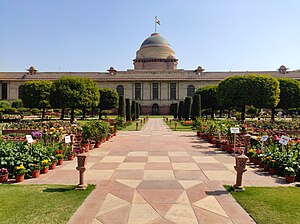The Largest Democracy

If you hear the media talk about "the world's largest democracy", you can be assured that it refers to the modern Republic of India: it is the world's most populous democratic state, with 1.21 billion inhabitants (nearly four times the size of the next-largest contender, the United States).
There are 23 official languages in India, 13 of which are spoken as a mother tongue by at least 10 million people, and 1,652 dialects. It contains the highest global Hindu population, the second most populous Muslim population, and significant Christian, Sikh and Jain minorities. One would think India would either fall apart or become dominated by a dictator/military-industrial complex and cease being a functional state. Instead, it's one of the developing world's most stable democracies, slipping into authoritarianism only once (the "Indian Emergency" from June 1975 to March 1977), and even then it took on a surprisingly mild (continuing to follow the constitutional forms and led by the duly-elected Prime Minister) and progressive (it was declared by Indira Gandhi—a woman) form.
There are many reasons why this has not happened, some of which include:
- The prevailing media narrative stresses social cohesion, unity and tolerance.
- Cricket. India is up there with Australia and South Africa as formidable and devoted cricketers.
- Bollywood and other Indian film industries: It's hard to find a people who are crazier about movies than Indians.
- No major group in India is in a position to dominate any other group. Granted, Hindus are a large majority, and could theoretically make things difficult for the other religious groups, but (1) Hindus are themselves divided linguistically and culturally and (2) the only times that a coalition led by Hindu nationalists came to power (The National Democratic Alliance, 1999-2004), their message was so watered-down they couldn't bring themselves to actually do anything on that front. The NDA government was in power at a time of much economic development but in spite of this was voted out in the 2004 General Election.
- Fragmentation among so many groups leads to a more laissez-faire approach culturally. If only two groups exist with differing narratives, conflict is inevitable: for example, Sri Lanka.
- As a result of this, relations between religions, while sometimes strained, are rarely violent (exceptions do occur, however). As evidence, two Muslims have held the (ceremonial) post of President of India, and the current Prime Minister (Manmohan Singh) is Sikh.
- Indian government mixes a federalist structure with significant state and cultural autonomy. Most states promote the language most prevalent in the state though they share the same currency, economy and civil structure. The link language and the most prominent language used by the Indian Government is English, a language that does not privilege or offend any ethnic group because of its foreign origin.
- Linguistic partitioning within a larger federal structure: most states are drawn around linguistic lines, although the Hindi-speaking north is divided into several states, and the currently-united Telugu-speaking areas (Andhra Pradesh) seem to be moving in that direction. The system is sufficiently successful that Nigeria eventually imitated it exactly, giving each linguistic group/tribe at least one state after other arrangements failed.
- The role of the Congress in the formative years of the Indian Republic. Founding Fathers matter.
- Mahatma Gandhi, the Father of India, who was probably the world's greatest philanthropist and leader to date. Despite everything India has been through, he managed to leave the nation a legacy of truth, justice and peace.
- Jawaharlal Nehru, India's first Prime Minister. The practical, politically-minded right hand to Gandhi, he set India on its political course after independence: federalist democracy in structure, socialism and self-reliance in economics (this was largely reversed in The Nineties), and non-alignment in foreign affairs (Nehru with Gamal Abdel Nasser, Josip Broz Tito, Kwame Nkrumah, Sukarno, and Haile Selassie founded the Non-Aligned Movement in 1961).
- He also inadvertently founded India's main political family—his daughter Indira Gandhi (no relation to Mahatma) and her son Rajiv were both Prime Minister in their time, and Rajiv's widow Sonia is the head of the Congress Party today (and seen as the main power behind the throne for PM Singh).
- The Indians With Iglas respect the idea of civilian control of the military absolutely.
Modern India
India today maintains the third largest military force in the world.
The Indian economy is the third-largest in the world by Purchasing Power Parity (PPP) at $4.5 trillion.
India today is considerably better off after the economic liberalization of the 1990s and is continuing to develop further. Its primary exports, in popular media and stereotypes, are:
- Indian cuisine
- Bollywood movies.
- Cobra beer.
- IT graduates. Seriously. India has the world's highest number of IT graduates, many of whom head abroad after they graduate. India is also a frequent destination for outsourcing.
With a population of over a billion, heading towards China in population size, India plays an important role in South Asia.